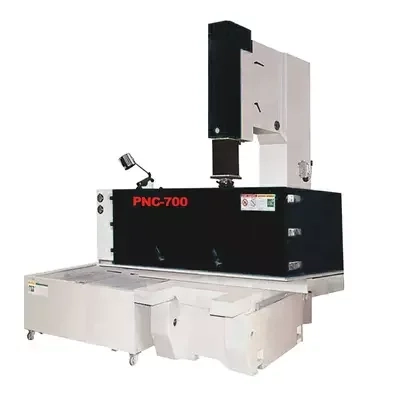EDM (Electrical Discharge Machining) die sinking machines are a crucial tool in the manufacturing industry, especially in the production of complex precision molds. This article aims to provide a comprehensive understanding of how EDM die sinking machines work, their components, and the entire process involved. Through in-depth study, we can appreciate their importance in modern manufacturing processes.
1. Understanding the basics of EDM die sinking machines:
EDM die sinking machines, also known as EDM sinkers or spark erosion machines, utilize electrical discharges to shape and form metal workpieces. The process involves the use of a conductive electrode and a workpiece submerged in dielectric fluid. The machine generates a series of electrical discharges between the electrode and the workpiece, eroding the material and creating the desired shape.
2. Components of EDM die sinking machines:
2.1 Power Supply: The power supply unit provides the necessary electrical energy to generate the electrical discharges. It controls the voltage, current, and pulse duration, ensuring precise and controlled erosion.
2.2 Control System: The control system manages the overall operation of the machine, including the movement of the electrode, the workpiece, and the dielectric fluid. It also monitors and adjusts various parameters such as pulse duration, current, and voltage.
2.3 Electrode: The electrode, typically made of graphite or copper, is the tool that shapes the workpiece. It is connected to the power supply and positioned above the workpiece, allowing electrical discharges to occur.
2.4 Workpiece Holder: The workpiece holder securely holds the workpiece in place during the machining process. It ensures stability and accuracy while allowing for precise movement and positioning.
2.5 Dielectric Fluid System: The dielectric fluid, usually deionized water, serves multiple purposes. It acts as a coolant, preventing the workpiece and electrode from overheating. It also acts as a medium for electrical discharges and flushes away eroded particles.

3. The EDM die sinking process:
3.1 Workpiece Preparation: Before the machining process begins, the workpiece is carefully prepared. This involves cleaning, deburring, and ensuring the surface is free from contaminants. The workpiece is then mounted onto the workpiece holder.
3.2 Electrode Selection: The appropriate electrode is chosen based on the desired shape and material of the workpiece. The electrode is carefully shaped to match the desired form and is securely attached to the electrode holder.
3.3 Dielectric Fluid Setup: The dielectric fluid is filled into the machine's tank, ensuring it covers the workpiece and electrode. The fluid is continuously circulated to maintain a consistent temperature and to flush away eroded particles.
3.4 Machining Parameters Setup: The operator sets the machining parameters such as pulse duration, current, and voltage based on the material and desired precision. These parameters are crucial in achieving the desired shape and surface finish.
3.5 EDM Machining: Once all the setup is complete, the machining process begins. The control system moves the electrode and workpiece relative to each other, maintaining a small gap between them. Electrical discharges occur in this gap, eroding the material from the workpiece. The dielectric fluid flushes away the eroded particles, preventing them from interfering with the process.
3.6 Finishing and Inspection: After the desired shape is achieved, the workpiece is removed from the machine. It undergoes further finishing processes such as polishing, deburring, and heat treatment if required. Finally, the workpiece is inspected for dimensional accuracy and surface quality.
4. Advantages of EDM die sinking machines:
4.1 Precision: EDM die sinking machines offer exceptional precision, allowing for the creation of complex and intricate shapes with tight tolerances.
4.2 Versatility: These machines can work with a wide range of conductive materials, including hardened steels, exotic alloys, and even conductive ceramics.
4.3 Surface Finish: EDM machining produces excellent surface finishes, reducing the need for additional polishing or grinding operations.
4.4 Minimal Material Waste: Since the process is non-contact, there is minimal material wastage, making it a cost-effective solution for intricate designs.
4.5 Tooling Longevity: EDM die sinking machines can extend the life of tooling by reducing wear and tear associated with traditional machining methods.
EDM die sinking machines have revolutionized the manufacturing industry by enabling the production of intricate and complex molds and dies. By utilizing electrical discharges, these machines offer exceptional precision, versatility, and surface finish. Understanding the components and the process involved in EDM die sinking machines helps us appreciate their significance in modern manufacturing processes. As technology continues to advance, EDM die sinking machines will undoubtedly play a crucial role in shaping the future of manufacturing.
Working environment and requirements of EDM wire cut machine
Analysis of environmental protection and energy saving technology of EDM wire cut machine
What are the advantages of EDM die sinking machine?
EDM die sinking machine maintenance and care guide
EDM die sinking machine purchasing guide and suggestions
Comparison of different types of EDM die sinking machines
Operation Guide for EDM Die Sinking Machines
Is the EDM die sinking machine expensive?
What are the uses of EDM die sinking machine?
Is the processing efficiency of EDM die sinking machine high?
mia
david@wxbofeng.com

More Stories
Defect Reduction in Aluminum Gravity Casting: X-Ray Inspection, Leak Testing, and Metallurgical Quality Control at Tiger Casting
Selecting the Right Mini PC Industrial i5 for Embedded Control, IoT, and Smart Manufacturing Applications
Essential Tips for Maintaining Aluminum Profiles After Professional Mechanical Polishing